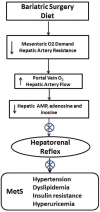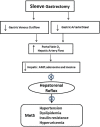Metabolic syndrome and the hepatorenal reflex
- PMID: 27656314
- PMCID: PMC5025922
- DOI: 10.4103/2152-7806.190438
Metabolic syndrome and the hepatorenal reflex
Erratum in
-
Erratum: Metabolic syndrome and the hepatorenal reflex.Surg Neurol Int. 2017 Feb 10;8:21. doi: 10.4103/2152-7806.199970. eCollection 2017. Surg Neurol Int. 2017. PMID: 28303201 Free PMC article.
Abstract
Insufficient hepatic O2 in animal and human studies has been shown to elicit a hepatorenal reflex in response to increased hepatic adenosine, resulting in stimulation of renal as well as muscle sympathetic nerve activity and activating the renin angiotensin system. Low hepatic ATP, hyperuricemia, and hepatic lipid accumulation reported in metabolic syndrome (MetS) patients may reflect insufficient hepatic O2 delivery, potentially accounting for the sympathetic overdrive associated with MetS. This theoretical concept is supported by experimental results in animals fed a high fructose diet to induce MetS. Hepatic fructose metabolism rapidly consumes ATP resulting in increased adenosine production and hyperuricemia as well as elevated renin release and sympathetic activity. This review makes the case for the hepatorenal reflex causing sympathetic overdrive and metabolic syndrome in response to exaggerated splanchnic oxygen consumption from excessive eating. This is strongly reinforced by the fact that MetS is cured in a matter of days in a significant percentage of patients by diet, bariatric surgery, or endoluminal sleeve, all of which would decrease splanchnic oxygen demand by limiting nutrient contact with the mucosa and reducing the nutrient load due to the loss of appetite or dietary restriction.
Keywords: Bariatric; cholesterol; diabetes; hepatorenal; metabolic syndrome; obesity; sympathetic.
Figures



Similar articles
-
Metabolic syndrome and the hepatorenal reflex.Surg Neurol Int. 2016 Nov 15;7:99. doi: 10.4103/2152-7806.194147. eCollection 2016. Surg Neurol Int. 2016. PMID: 28168086 Free PMC article. Review.
-
High fructose consumption combined with low dietary magnesium intake may increase the incidence of the metabolic syndrome by inducing inflammation.Magnes Res. 2006 Dec;19(4):237-43. Magnes Res. 2006. PMID: 17402291 Review.
-
Exercise training modulates the hepatic renin-angiotensin system in fructose-fed rats.Exp Physiol. 2017 Sep 1;102(9):1208-1220. doi: 10.1113/EP085924. Epub 2017 Jul 26. Exp Physiol. 2017. PMID: 28626963
-
Decreases in portal flow trigger a hepatorenal reflex to inhibit renal sodium and water excretion in rats: role of adenosine.Hepatology. 2002 Jan;35(1):167-75. doi: 10.1053/jhep.2002.30425. Hepatology. 2002. PMID: 11786973
-
Reflex effects of hepatic baroreceptors on renal and cardiac sympathetic nerve activity.Am J Physiol. 1980 May;238(5):R390-4. doi: 10.1152/ajpregu.1980.238.5.R390. Am J Physiol. 1980. PMID: 7377377
Cited by
-
Erratum: Metabolic syndrome and the hepatorenal reflex.Surg Neurol Int. 2017 Feb 10;8:21. doi: 10.4103/2152-7806.199970. eCollection 2017. Surg Neurol Int. 2017. PMID: 28303201 Free PMC article.
-
Maternal Venous Hemodynamic Dysfunction in Proteinuric Gestational Hypertension: Evidence and Implications.J Clin Med. 2019 Mar 11;8(3):335. doi: 10.3390/jcm8030335. J Clin Med. 2019. PMID: 30862007 Free PMC article. Review.
References
-
- Abbatini F, Rizzello M, Casella G, Alessandri G, Capoccia D, Leonetti F, et al. Long term effects of laparoscopic sleeve gastrectomy, gastric bypass, and adjustable gastric banding on type 2 diabetes. Surg Endosc. 2010;24:1005. - PubMed
-
- Abdelmalek MF, Lazo M, Horska A, Bonekamp S, Lipkin EW, Balasubramanyam A, et al. Fatty Liver Subgroup of Look AHEAD Research Group. Higher dietary fructose is associated with impaired hepatic adenosine triphosphate homeostasis in obese individuals with type 2 diabetes. Hepatology. 2012;56:952–60. - PMC - PubMed
-
- Aguilar M, Bhuket T, Torres S, Liu B, Wong RJ. Prevalence of the metabolic syndrome in the United States 2003-2012. JAMA. 2015;313:1973–4. - PubMed
Publication types
LinkOut - more resources
Full Text Sources
Other Literature Sources
